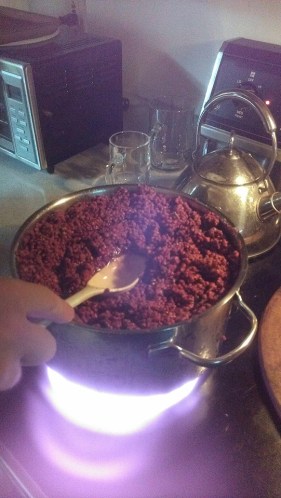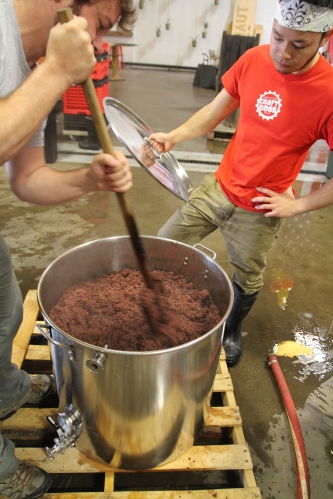O brave new world that has such berries in it! Our beer experimentation has taken us to strange new places. This weekend, we are introducing our sumac beer, which we’ve named “Field Day” for reasons that should become apparent. The concept for sumac beer came about around a year ago, back when we were still prototyping beers in the backyard, sans brewery. The summer was ending, and we were looking for seasonal fruits to add to our beers. During our long drives through central and western Mass., we’d pass endless rows of sumac plants, with their drupes of berries pointing skyward like so many fingers making a suggestive “come hither” motion as they swayed in the traffic-induced breeze. In late August, the berries color the roadside and typically remain untouched by human or animal through the winter. This was not always the case. As I learned from Euell Gibbons years earlier, the American Indians used sumac berries to make a tart drink akin to lemonade. What better way to welcome the end of summer than to incorporate this widely available MA-native plant? We found a roadside cache of the berries and gathered up a bushel or so. Then, we summoned some good friends to help us pick the berries from the stems.

Of course, sumac berries aren’t as gentle on the hands as the supple strawberry, or the delicate currant. No, they are fuzzy and a bit scratchy. It was no easy task to get the berries prepped, but eventually we stuck it out and found ourselves with the makings of a sumac extract, which we then incorporated into two different styles of beer–American wheat, and a light pale ale.


Both turned out excellent, showcasing the pink color of the sumac, and its gentle fruity acidity, arising from the healthy dose of malic acid, found in the fuzz of the sumac berries. We resolved to repeat the process at our brewery, once it was established.
Summer 2014. Aeronaut Brewing Company is alive and kicking. We found ourselves in the midst of a busy first season at Aeronaut. While doing our best to keep beer in stock, we also kept an eye toward new and seasonal beers. August sauntered in and thoughts of the sumac beer crept back into our forebrains. This time, how much would we need to make a brewery-sized quantity of sumac beer? How would we get it, and how would we ensure the quality of a plant that grows wild? We decided to source the sumac from a farm, rather than the roadside this time. Although sumac isn’t widely cultivated, the plants have a penchant for growing at the edges of fields, where sunlight is plentiful. We asked our friends at Four Star Farms, who had recently supplied us with fresh hops for our Northfield IPA. Not only did they confirm that their fields were surrounded by sumac plants, the told us they’d be happy to have us harvest whatever we’d like! And they could confirm that the plants were untouched and unsprayed. Great news. Now…how to harvest the right quantity?
We did some quick calculations and realized we’d need a rather large bounty of the berries. Accordingly, we assembled a small team of excited volunteers to accompany us to the farm out in Northfield. Together, we trucked westward on a Monday morning and spent the day snipping berry clusters and collecting them in the bed of our pickup truck.

Once we had it all collected, we headed back to Aeronaut. That evening, we called in reinforcements. Around a dozen of us spent the evening hours picking apart the berries and getting them ready for their debut. Thanks, team!


Finally, it was brew day. We’d decided to go with a pale ale base. To get the sumac ready, we created a parallel mini-mash for the sumac extraction, while the grain extraction proceeded as normal.

After we were satisfied that the sumac tea was ready, and the pH was low enough, we let the sumac meet the beer. The bright red liquid flowed out of the pot, leaving behind the flavorless berry husks. Adding enough of it would lend a pinkish hue to the unfermented wort.

After that, we continued the brew as normal. We’d later find challenges involving extra haze contributed by the sumac proteins, but we persevered, and today, we bring you the product of our efforts. We think the beer is wonderfully refreshing, sour, bitter and citrusy. We can’t help but be reminded of grapefruit juice when we drink it. May “fair thought and happy hours attend you” as you imbibe.


